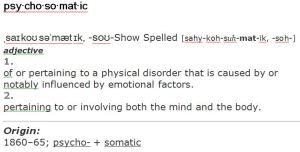Smoking Cessation, No Butts About It
 Smoking cessation. I don’t talk about it much, but it, along with weight loss, is one of the two subjects most associated with Hypnotherapy by the general public. A lot of hypnotherapists, myself included, consider it hypnotherapy 101, something you can advertise to build a clientele but something you generally drift away from as more diverse cases come your way. (And I have.)
Smoking cessation. I don’t talk about it much, but it, along with weight loss, is one of the two subjects most associated with Hypnotherapy by the general public. A lot of hypnotherapists, myself included, consider it hypnotherapy 101, something you can advertise to build a clientele but something you generally drift away from as more diverse cases come your way. (And I have.)
I had a conversation with an old client the other day and it really made me take a look at my attitude on the subject. While Stop Smoking programs are relatively simple exercises, they are programs that profoundly change the lives of the clients.
The behavior of smoking is almost tailor made to be dealt with by hypnosis. The actually physical addiction, while very strong, is actually very short lived. Most of the physical withdrawal is over in a week or less. Amazingly, nicotine is not the worst culprit with cigarettes. It’s all the other chemicals that have been added specifically to add “punch” to the nicotine hit and cause the psychological addiction. Case in point, you almost never, and I have never, seen a client with an addiction to nicotine patches or gum. So the vast majority of the addiction is not physical. It has to do with the client’s mental associations to smoking, their feelings about it and how it applies to them. It is therefore able to be dealt with efficiently with hypnosis.
So, smoking is mostly a learned behavior and smoking cigarettes is literally one of the worst “lose-lose” behaviors a person can have. Smokers may believe that it: calms them down, suppresses their appetite or just makes them look cool, but it actually does none of those things. It is a stimulant that, instead of calming them down, actually “jacks them up.” It only seems to suppress appetite because it deadens the taste buds, suppresses the sense of smell and generally makes food taste crappy. It doesn’t look cool; it looks nasty and smells even worse. And of course it has the pesky little issue of causing SLOW PAINFUL DEATH. This makes smoking cessation one of the more profound programs a hypnotherapist can do. Instead of helping cancer patients with pain and the nausea of chemo, wouldn’t it be better to stop the cancer from happening in the first place?
With that in mind and with the RelaxNow program up and running, I have started taking Stop Smoking clients for the first time in many years. Since my schedule only allows for a few individual clients, I’ve also started putting my mind to creating a recorded program to take it past what can be done one on one. I’ll post more as things develop.
Ideomotor Response (Your own personal truth detector)
“Ideomotor phenomenon: is a psychological phenomenon wherein a subject makes motions unconsciously.”
The ideomotor response is an interesting tool used by hypnotherapists and others. It uses involuntary muscle movement to facilitate gathering information from the unconscious mind.
A simple method, that requires no trance at all, is to use a pendulum. This is something you can try for yourself. Find something that can be used as a pendulum, a necklace, or even just a small weight tied on the end of a string. Sit comfortably so that you may rest your elbow on your leg, the arm of a chair, or on a table. Just place yourself in a position where you can hold forearm and hand steady and motionless. Gently grip the pendulum between your thumb and forefinger so that it can hang straight down and move freely. Don’t move it, just let it hang there.
Now you must “set” the pendulum by letting your unconscious mind know what motion means to answer yes and what means to answer no. (You only have to do this once, the “set” will last a lifetime.)
Relax as much as you can and start thinking the word yes over and over. As you are thinking the word yes, just imagine the pendulum swinging front to back. Important: Do not swing the pendulum just think about it swinging. Very soon the pendulum will start swinging front to back seemingly all on its own. Once it is moving steadily front to back, start thinking the word no over and over and imagine the pendulum swinging left and right. Once again, do not physically do anything to make the pendulum change direction or affect it in anyway. Just keep your arm and hand relaxed and steady and imagine it changing directions and then wait for it to happen.
Continue using just your mind to change the direction of the pendulum from left to right to front to back several times. You may even add a non-response; if the answer to a question is unclear pendulum will swing in the circle. After you can reliably change the motion of the pendulum using just your mind, put it down, walk away and do something else for a while.
You now have your own “personal truth” detector. If you are ever in doubt of what you really think about something you can use the pendulum. You can write a question on piece of paper and hold the pendulum over it and observe its motion. Or you can just hold the question in your mind. Just remember you must simplify the question down to its essence and have it in a form that can be answered with a yes or a no.
This is just one kind of ideomotor response. There are many others. In a hypnotherapy setting (or any talk-therapy) it can be as simple as telling the client that his/her index finger will move for a positive response and the middle finger will move for a negative response. Then have the client sit back, close his/her eyes and discuss his/her issues. You can see if the ideomotor response is contradicting the verbal responses. This can help pinpoint where the motivations of the unconscious mind contradict and work against the desires of the conscious mind. The client may be adamantly telling you how much she desires to: lose weight, quit drinking, relieve chronic pain, etc. But the fingers are screaming no, No, NO!
Wes Graham C.C.Ht.
RelaxNow for older children and Adults
 I’ve just finished the recording and the first mix downs of the new version of RelaxNow . This version is slightly longer the original and geared more for older children and adults.
I’ve just finished the recording and the first mix downs of the new version of RelaxNow . This version is slightly longer the original and geared more for older children and adults.
I have also have taken some of the natural sounds of the RelaxNow programs and created, what we’re calling for now, Ambient background tracks. These are designed to be played softly in the background to help with sleep or just to unwind. These peaceful sounds can be relaxing for anyone but for someone who has regularly used the RelaxNow program they should be doubly effective.
We now start the testing and editing process. With luck these new recordings will be available in a few week (hopefully) or a few months (if past is prolog.) 🙂
Wes Graham C.C.Ht.
Please visit us on the web:
RelaxNow Homepage Like us on Facebook RelaxNow YouTube
Hypnosis and Autism, a new project
 As so often happens, the greatest of projects can start from the smallest of things; a chance meeting or in this case a random bit of dinner conversation. Over the Christmas holidays, my wife and I were having dinner with a couple we have known for close to 20 years. The wife, Sheila S., runs a school for children on the autism spectrum. She is also a well-respected consultant to both the parents of autistic children and to their teachers. During the course of the evening the talk turned to “her kids.” She mentioned that she had started doing something she called “Relaxation Time.” She would have the kids lie down and she would quietly tell them to “let your feet go to sleep, your legs, etc.” Those of you already involved with hypnosis will recognize as I did that she was unknowingly doing a basic fractional relaxation hypnotic induction. I was instantly hooked, and I asked if I could observe one day and she agreed.
As so often happens, the greatest of projects can start from the smallest of things; a chance meeting or in this case a random bit of dinner conversation. Over the Christmas holidays, my wife and I were having dinner with a couple we have known for close to 20 years. The wife, Sheila S., runs a school for children on the autism spectrum. She is also a well-respected consultant to both the parents of autistic children and to their teachers. During the course of the evening the talk turned to “her kids.” She mentioned that she had started doing something she called “Relaxation Time.” She would have the kids lie down and she would quietly tell them to “let your feet go to sleep, your legs, etc.” Those of you already involved with hypnosis will recognize as I did that she was unknowingly doing a basic fractional relaxation hypnotic induction. I was instantly hooked, and I asked if I could observe one day and she agreed.
While watching Sheila go through her Relaxation Time routine with the kids I observed that some of the kids were truly drifting into a very light trance state. I immediately saw the potential to do some good here if I could devise a way of developing a deeper trance state in children whose sensory perceptions and mental processes can be profoundly different from my own.
After much consideration I settled on a combination of an abbreviated traditional hypnosis induction and my Audio-Homeopathy techniques along with with subliminal reinforcements (to avoid over stimulation). I also needed to determine what would be best to use as a first hypnotic suggestion. I began to observe the classes on an ongoing basis and saw the first and foremost need these children had, at least in this environment, was energy management. The minds of these kids can sometime be overwhelmed by situations and sensory inputs that a person not on the spectrum might easily miss or ignore. I soon had a test program recorded and we began our first trials.
The first suggestion/tool I choose for this program was a relaxation trigger that the child could use on themselves or have an authority figure such as a parent or teacher use for them. I chose the words “Relax Now” as the trigger with the suggestion that: when the child says out loud or silently “Relax Now” he instantly relaxes “to an appropriate level.” Appropriate level is a key point. This suggestion is not an on/off switch to be “flipped.” It’s more like a throttle that the child can use to rein in his or her response to mental or physical overstimulation.
Right from the very first day the results were promising. About an hour after going through the Relaxation Time program, one of the students began to become agitated. Sheila S. used the Relax Now trigger and there was a small, but noticeable de-escalation. I honestly did not expect to see any results until the children had been through the program several times and was very pleased and more than a little surprised to see a visible result the first day. There was a noticeably calmer mood to all the classes after Relaxation Time that day. Sheila S. also reports a generally calmer demeanor in all the participating classes throughout the entire six months of our trial period.
I can’t emphasize enough that Relaxation Time is not a program to control children; it is a program for children to use to help control themselves. Others can assist, but when others use the trigger words the child is always the final arbiter of who they will respond to and how much they will respond.
The benefits of a program of this type are not limited to children on the autistic spectrum. I can see where it could be useful for children with ADD or any child that sometimes gets overwhelmed or has issues with focus.
Over the last six months we have had 25 students participate in the program and after several small modifications I am happy to say the Relaxation Time program is now ready for public release. I am currently working on the new website and I will soon have a link here on this page to where Relaxation Time can be purchased and downloaded. In the meantime please feel free to use the Contact Me link on this blog to ask me any questions you have.
Thank you very much,
Wes Graham C.C.Ht.
A Bridge to the Unconscious Mind
Why is it always about breathing? Whether you’re in a karate dojo, a yoga class or a hypnotherapist’s office, they’re always prattling on and on about breathing. “Take three cleansing breaths.” “Imagine your breath going here, going there.” Why all this focus on a bodily function that’s as basic as your heartbeat? It’s because breathing is different.
Your conscious thinking mind, for the most part, has no direct effect on most of the functions of your autonomic nervous system. You don’t “think” about secreting cortisol from your adrenal gland, you don’t “think” about your heartbeat and most of the time you don’t think about your breathing, but you can. Right now you can choose to breathe faster, slower, hold your breath. Try holding your heartbeat. (Go on, I dare you.)
The unconscious mind. (We really need a better name for it, as it is not “un” conscious at all, but let’s save that for another posting.) Okay, moving on, the unconscious mind does have an effect. In fact, it could almost be said that the autonomic nervous system IS the unconscious mind, with what we typically call the unconscious “mind” being simply the portion of the system that regulates behavior like the hypothalamus regulates body temperature. (Among other things)
It make very logical sense that when we want to pass information from the thinking mind to the unconscious “operating system” and vice versa, we use the few functions that are under the control of both system (breathing, eye blinking) as a bridge.
The language of the unconscious “mind” is a visual metaphor so you will find everyone from the Hypnotherapist in his office, the Yogi on the mountaintop, to the Massage therapist giving chair massages in the mall, telling you to “focus on your breathing,” visualize it as this color or that. See it going here or there. Breathing is a bridge between the conscious and the unconscious. This bridge runs both ways. You can “inhale” a healing light as well as “exhale” stress or pain.
We live in a time when science and logic seem to be at war with ancient wisdom that has stood the test of time. In this day and age so many alternative practices are looked down upon as metaphysical and so much “woo woo voodoo,” but when we truly understand the logic behind these practices, they can make sense and are as much physics as metaphysics.
Wes Graham C.C.Ht.
Depth of Trance, Who is in Control?
It is a common misconception, based on the representation of hypnosis on TV and in films, that a hypnotized subject is like a zombie under the Svengali-like control of the hypnotist. This image is also reinforced by the routines of stage hypnotists, whose use of a deep somnambulistic (similar to sleep-walking) trance states make for an entertaining show. The therapeutic use of hypnosis is quite different. In a therapeutic setting the depth of the trance is not nearly so important and mostly at the discretion of the subjects, whether they know it or not.
The hypnotherapist is basically a facilitator and guide; it is the clients that are ultimately the judge of what they need. For some, the experience they require for positive change is a deep, almost hallucinogenic trance state and that’s what they will naturally go to. For others, a simple game of “close your eyes and make believe” is exactly what they need and that’s what they will naturally go to. Both extremes and everything in-between can and will work for the clients if the hypnotherapist just allows them to go where they need to go and then just helps them deal with what comes up.
As is often said, all hypnosis is Self-Hypnosis. Either consciously or unconsciously, it is always voluntary. The process of calling, setting the appointment and sitting down with a hypnotist is a significant part of the initial hypnotic induction. Yes, I, like most hypnotherapists, will start with some basic inductions and tests. This gives me a feel for how the client responds (where they want/need to go), but more importantly, it gives the client’s unconscious mind a reference point for the tools and experience of hypnosis that has already begun just by being there.
Wes Graham C.C.Ht.
Rational Irrationality
On a recent trip to Austin TX. I visited Natural Treasures, a store that specializes in stones, crystals and various “New Age” accoutrements. They often have different alternative practitioners doing sessions in the store. On this day there was a gentlemen, Kramer Wetzel, doing Astrological readings and on a whim I decided to give it a try.
Now, I generally look at the world through what I consider a very rational, almost scientific, lens, I try to understand why and how things work. There is no way my rational mind can wrap itself around the proposition that the position of the planets and stars, cross referenced with the time and date of your birth, can tell you anything about your past, your future or your current circumstance, it’s just irrational. That being said, I received a very accurate reading. I detected no “cold reading” technic or any other misdirection or tricks.
This got me thinking, when you think about it; we seem to live in an irrational universe. The fact that some sub-atomic particles can simultaneously exist and not exist, or have no location or mass until someone decides to measure it seems pretty crazy and irrational to me but it has been tested again and again and proven to be so.
When we wake up every morning in a universe where rational logic says we should be able to walk through walls because they (and us) are 99.999999999999******% empty space, is it that much of an intellectual stretch to say that “something” ties us to the stars, or the tarot cards, or the tea leaves, whatever. I suspect that what we now consider irrational is no such thing. We have only existed as a species for an incredibly short period of time. By universal standard we only figured out fire a tiny fraction of a second ago, maybe what seems irrational now is just stuff we haven’t figured out yet.
I never want to just believe something offhand, so I always refer back to Arthur C Clarke’s 3 laws, especially law number 3.
1.When a distinguished but elderly scientist states that something is possible, he is almost certainly right. When he states that something is impossible, he is very probably wrong.
2.The only way of discovering the limits of the possible is to venture a little way past them into the impossible.
3.Any sufficiently advanced technology is indistinguishable from magic.
Wes Graham C.C.Ht.
The Message is now available on Google Play
The Message is now available on Google Play as well as on iTunes and Amazon.com. The new link is at the bottom of the page.
In this world you can have anything you want; the hard part is knowing what that truly is.
The Message is a guided meditation with a nice long hypnotic induction. The purpose of The Message is to open a channel of communication with an individual’s own unconscious mind. To help that individual to discover what their unconscious mind is really trying to tell them.
While The Message does not employ many of my Hypno-Energetics technics, it does use some of the latest wild crafted sound I’ve recorded. I’ve also included a bonus track, a subliminal loop to play while sleeping. It contains positive affirmations for self-esteem and self-confidence.
Download it from Google Play http://bit.ly/1dXUyTf
Download it from iTunes http://bit.ly/14LFfIb
Download it from Amazon.com http://amzn.to/1cQIjuG
What is Hypnosis?
What is Hypnosis, that’s a good question. This is the explanation of the basic concept of hypnosis that I use in some of my recorded programs.
Thanks for listening,
Wes Graham C.C.Ht.








